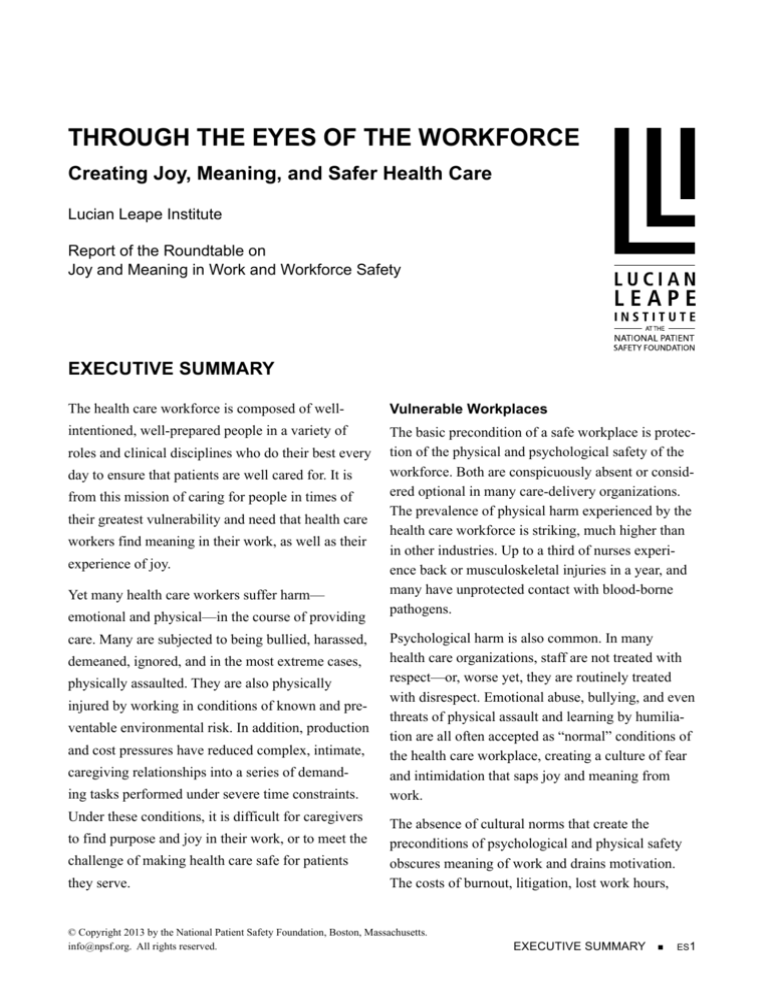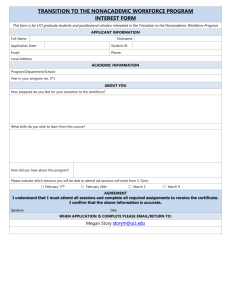
Through the Eyes of the Workforce
Creating Joy, Meaning, and Safer Health Care
Lucian Leape Institute
Report of the Roundtable on
Joy and Meaning in Work and Workforce Safety
EXECUTIVE SUMMARY
The health care workforce is composed of well-
Vulnerable Workplaces
intentioned, well-prepared people in a variety of
The basic precondition of a safe workplace is protection of the physical and psychological safety of the
workforce. Both are conspicuously absent or considered optional in many care-delivery organizations.
The prevalence of physical harm experienced by the
health care workforce is striking, much higher than
in other industries. Up to a third of nurses experience back or musculoskeletal injuries in a year, and
many have unprotected contact with blood-borne
pathogens.
roles and clinical disciplines who do their best every
day to ensure that patients are well cared for. It is
from this mission of caring for people in times of
their greatest vulnerability and need that health care
workers find meaning in their work, as well as their
experience of joy.
Yet many health care workers suffer harm—
emotional and physical—in the course of providing
care. Many are subjected to being bullied, harassed,
demeaned, ignored, and in the most extreme cases,
physically assaulted. They are also physically
injured by working in conditions of known and preventable environmental risk. In addition, production
and cost pressures have reduced complex, intimate,
caregiving relationships into a series of demanding tasks performed under severe time constraints.
Under these conditions, it is difficult for caregivers
to find purpose and joy in their work, or to meet the
challenge of making health care safe for patients
they serve.
Psychological harm is also common. In many
health care organizations, staff are not treated with
respect—or, worse yet, they are routinely treated
with disrespect. Emotional abuse, bullying, and even
threats of physical assault and learning by humiliation are all often accepted as “normal” conditions of
the health care workplace, creating a culture of fear
and intimidation that saps joy and meaning from
work.
The absence of cultural norms that create the
preconditions of psychological and physical safety
obscures meaning of work and drains motivation.
The costs of burnout, litigation, lost work hours,
© Copyright 2013 by the National Patient Safety Foundation, Boston, Massachusetts.
info@npsf.org. All rights reserved.
EXECUTIVE SUMMARY n ES1
THROUGH THE EYES OF THE WORKFORCE
employee turnover, and the inability to attract newcomers to caring professions are wasteful and add
to the burden of illness. Disrespectful treatment of
workers increases the risk of patient injury.
What Can Be Done?
An environment of mutual respect is critical if the
workforce is to find joy and meaning in work. In
modern health care, teamwork is essential for safe
practice, and teamwork is impossible in the absence
of mutual respect.
Former CEO of Alcoa Paul O’Neill advises that, to
find joy and meaning in their daily work, each person in the workforce must be able to answer affirmatively to three questions each day:
1. Am I treated with dignity and respect by
everyone?
2. Do I have what I need so I can make a
contribution that gives meaning
to my life?
3. Am I recognized and thanked for what I do?
Developing Effective Organizations
To create a safe and supportive work environment,
health care organizations must become effective,
high-reliability organizations, characterized by
continuous learning, improvement, teamwork, and
transparency. Effective organizations care for their
employees and continuously meet preconditions not
subject to annual priority and budget setting. The
most fundamental precondition is workforce safety,
physical and psychological. The workforce needs
to know that their safety is an enduring and nonnegotiable priority for the governing board, CEO,
and organization.
Knowing that their well-being is a priority enables
the workforce to be meaningfully engaged in their
work, to be more satisfied, less likely to experience
burnout, and to deliver more effective and safer care.
Achieving this vision requires leadership. The
governing board, CEO, and organizational leaders
create the cultural norms and conditions that
ES2 n EXECUTIVE
SUMMARY
Creating Joy, Meaning, and Safer Health Care
produce workforce safety, meaning, and joy.
Effective leaders shape safety culture through
management practices that demonstrate a priority to
safety and compassionately engage the workforce
to speak about and report errors, mistakes, and
hazards that threaten safety—their own or their
patients’. Joy and meaning will be created when the
workforce feels valued, safe from harm, and part of
the solutions for change.
Recommendations
Strategy 1: Develop and embody shared
core values of mutual respect and civility;
transparency and truth telling; safety of all
workers and patients; and alignment and
accountability from the boardroom through the
front lines.
Strategy 2: Adopt the explicit aim to eliminate
harm to the workforce and to patients.
Strategy 3: Commit to creating a high-reliability
organization (HRO) and demonstrate
the discipline to achieve highly reliable
performance. This will require creating
a learning and improvement system and
adopting evidence-based management skills for
reliability.
Strategy 4: Create a learning and improvement
system.
Strategy 5: Establish data capture, database, and
performance metrics for accountability and
improvement.
Strategy 6: Recognize and celebrate the work and
accomplishments of the workforce, regularly
and with high visibility.
Strategy 7: Support industry-wide research to
design and conduct studies that will explore
issues and conditions in health care that are
harming our workforce and our patients.








